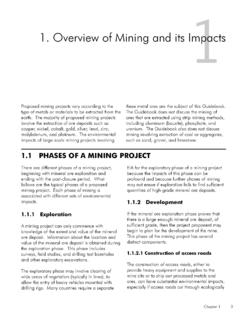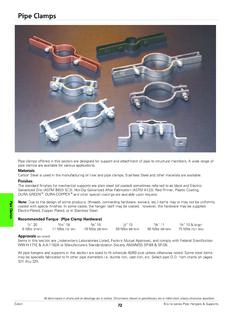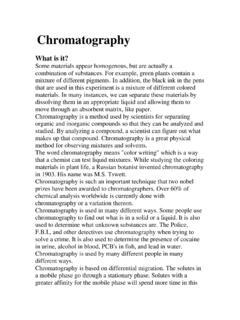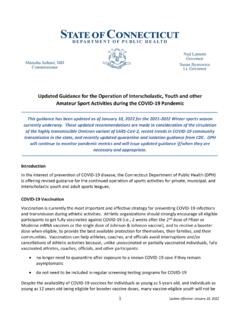Transcription of Background information Year 7, unit 1: Mixing and …
1 Additional information for teachers Background information year 7, unit 1: Mixing and separating Mixtures When two or more kinds of matter are put together a mixture is formed. The process of being mixed does not change the components of a mixture and they retain their individual properties. Mixtures are combinations of substances that are not combined chemically.
2 The amounts of substances in a mixture can vary. Students should understand that mixtures can change in appearance but this does not mean that the chemical composition of any of the substances has changed. Most substances found in nature are mixtures. Mixtures can occur in any of the four phases of matter or they can be in combinations of different phases. Air is a mixture of gases, milk is a mixture of solids and liquids, alloys are mixtures of solids. The combinations of substances in a mixture give it properties that are different to those of the original substances. Each component has a particular purpose. For example, in sherbet the sugar and jelly crystals add sweetness and flavour while the acids and bicarbonate soda react with saliva to produce carbon dioxide that gives the fizziness.
3 In a bubble mixture of detergent, water and glycerine, the detergent makes the film that the water particles stick to and the glycerine strengthens the bubbles. Varying the amounts of the different components will change the properties of a mixture. For example, adding more sugar to a cup of tea will make it sweeter, adding more pigment to a paint will make the colour darker, adding water to paint will make it runny and easier to spread but may decrease depth of coverage. Types of mixtures Mixtures can broadly be divided into two categories heterogeneous mixtures and homogeneous mixtures. Heterogeneous mixtures are ones in which the individual components are not mixed evenly throughout the mixture.
4 Homogeneous mixtures are more easily distinguished, as the different components are more easily seen. Examples of heterogeneous mixtures include oil and water , sand and water , muesli and chocolate chip cookies. Homogeneous mixtures are ones in which the different components are evenly mixed and these mixtures look the same throughout. All solutions are classified as homogeneous mixtures. Examples of homogeneous mixtures are salt water , clean air and skim milk. Solutions Solutions have only one phase and the most common solutions are liquids, although there can be solutions of gases (air) and solids (alloys). 2013 Education Services Australia Ltd, except where indicated otherwise. You may copy, distribute and adapt this material free of charge for non-commercial educational purposes, provided you retain all copyright notices and acknowledgements.
5 1 Additional information for teachers In a solution the substance that is dissolved is the solute. The liquid that does the dissolving is the solvent. water is a common solvent. separating mixtures Sometimes mixtures need to be separated back into the substances that were originally mixed together because one or more of these substances may be particularly valuable or useful.
6 For example: wheat is separated from chaff to obtain the seeds salt is separated from salt water gold panning separates particles of gold from dirt, sand and rocks fresh water is obtained from dirty water or sea water . When mixtures are separated the technique used is based on the physical properties of the substances that make up the mixture. The original substances are retrieved unchanged. Salt and water are mixed to produce salt water and the salt can be retrieved by evaporating the water . The salt retrieved is the same as the salt which was dissolved. Mixtures may also need to be separated for other purposes. Processes like drug testing at the Olympics can measure trace amounts of banned substances in an athlete s blood.
7 Foods are regularly tested for levels of a variety of different substances to make sure the manufacturer s claims are true and in order to protect our health. Rubbish can be separated into recyclable material , composting material and material for dumping. This process is good for the environment because it reduces the amount of material going into landfill. There are many different techniques for separating mixtures. These include: handpicking threshing winnowing jigging and panning filtering (or sieving or straining) evaporating or boiling freezing chromatography. Each of these techniques relies on differences in properties between mixtures and each of the components in the mixture.
8 Handpicking This is a basic method of separating substances. It involves picking out substances by hand and separating them from others. It is a manual process and used when the components of the mixture to be separated are large and easily distinguished. Removing almonds from a nut mixture, collecting shells on the beach or separating recyclable plastics from a mixture of plastics, all involve handpicking. 2013 Education Services Australia Ltd, except where indicated otherwise. You may copy, distribute and adapt this material free of charge for non-commercial educational purposes, provided you retain all copyright notices and acknowledgements. 2 Additional information for teachers Threshing Threshing is the process of separating grain from the stalk.
9 It involves beating the dry stalks to shake off the dried grains. Traditionally, threshing was done by hand, however today threshing machines are used to separate large quantities quickly. Winnowing This technique is often carried out following threshing. Although the grains have been separated from the stalks they still have dried husks and chaff that have to be removed before the grains can be used. Winnowing is the separation of the heavier particles (grains) from the lighter husk and chaff using wind or moving air. The mixture, held in a basket, is thrown up in the air, wind blows the lighter particles away and the heavier grains are the caught again in the basket. This process needs to be repeated several times to achieve good separation.
10 Handpicking, threshing and winnowing have been used for centuries by ancient cultures such as Indigenous Australians, the Greeks, Indians, Chinese and Egyptian. These techniques are still used by a variety of peoples today. Jigging and panning Jigging is one of the oldest processes used to separate heavy minerals as well as gold and gemstones from lighter soils and pebbles. It can be done by both hand and by mechanical processes. Both processes rely on differences in density of the materials to be separated. In this process the mixture is added to a bucket of water that is then plunged up and down in a tub or under a stream flowing water . The force of the water separates the light and heavy fragments.










